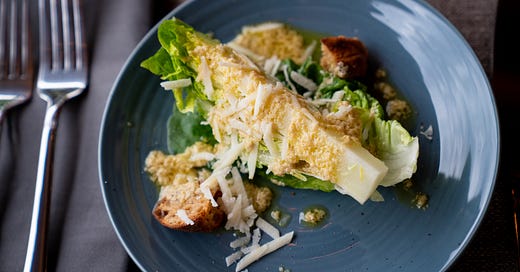Growing up, food was my family’s religion.
I never put my hair in ringlets nor tried to awkwardly squeeze into a pink dress (I was never the skinny kid nor the girly girl for that matter) to attend church.
In fact, the only time I remember going into a church as a kid was when my grandma died. I was 15 when she passed away. And, I will say that to this day I’ve never had a better anise cookie than hers.
Since her passing, many of my family members try, year after year, to replicate her anise cookie recipe. They all follow the exact recipe that she used, the one written in pencil on the back of an index card that still sits in her recipe box on the kitchen counter she once baked at - yet they never taste the same. Even though they follow her recipe, to a T.
Food was always the main topic of conversation and interest in our household. During the day, my mom would have The Food Network playing in the background. Often, when she heard an inspiring recipe she’d quickly run into the living room, notepad and pencil in hand as she’d jot down new recipe inspirations from her favorite chefs like Emeril, Giada, Ina Garten and Sandra Lee.
However, Sandra Lee would often get muted as her catch line, Semi Homemade Cooking, didn’t fly in our family. Nothing was ever semi homemade. It was always homemade. I can hardly remember eating anything but a homemade meal prepared each night by my mother.
When it came to food, quality of ingredients as well as traditional cooking methods were always of great importance. My Sicilian grandfather, Carl Trubio (whom his over 23 grandchildren, including myself called, Poppie), loved making cannolis and he made the absolute best ricotta filled cannolis.
Not only did he make the filling and shells from scratch, he welded molds to make the cannoli shells. He’d roll the dough for the shells, wrap them around the molds ( that, by the way, he welded by hand in his basement) and would then proceed to gently place them in a bath of hot lard to make the cannoli shell. Like I said, my family valued traditional cooking methods. Even if it meant welding your own cannoli molds. When it comes to food, we don’t F around.
Ingredients had to be fresh, everything scratch made - - arriving to my house with canned tomato sauce would have likely ended in a death sentence. This is my guess as nobody dared to attempt this. But, there was also no need to as it’s common knowledge in the small town I was raised that my mother makes the best homemade sauce leaving no need for the canned version.
Like canned tomato sauce, commercial Caesar dressing would have no place in my mother’s kitchen (nor mine for that matter).
While I wish I could say that my Caesar dressing recipe is an ancient family heirloom, one that had been hidden away for centuries in the attic and stuffed into a dusty wooden chest, written with a reed pen on a flimsy piece of paper that I stumbled upon years ago, it is not.
I sense this is because Italians opt for a simpler approach to dressing - olive oil, vinegar and herbs are all they need to accompany their raw greens - which is why no one in my family has ever inherited an age-old Caesar dressing recipe. Even though Caesar dressing was invented by an Italian, it isn’t a very popular salad dressing in Italy.
But, it was a popular salad dressing for my family growing up as it is for me today. My wife would eat Caesar salad every night if I made it.
Over the years, many who have tasted my Caesar dressing have asked for the recipe. I have never given it.
This isn’t out of fear that someone is going to steal my recipe or that they’ll manipulate it to make millions or brand it (however, it is that good). No, none of that.
It’s because I never write my recipes down. Ever. Until I started writing my cookbook which I started, well, yesterday.
When it comes to making any food, meal or dish I primarily go off of look, taste, feel and intuition to guide my cooking. I rarely follow recipes. I actually can’t remember the last time I followed a recipe.
When I make a new dish, I might follow a recipe. But then, I taste it and adjust to my liking and preferences. Or, I swap ingredients such as raw honey when it calls for cane sugar, etc.
You particularly have to adjust ingredient amounts when making Caesar dressing. Even the recipe I share with you below will need a little more of this or a little more of that. You must taste it after you blend it to see what your palate thinks and wants. Actually, I advise doing this with every recipe you make.
Often, with Caesar dressing, you will need to add a little more vinegar or mustard or pecorino despite what any recipe calls for.
The anchovies (whatever you do don’t nonchalantly brush off this ingredient) will also change the flavor of your dressing depending on if they’re fresh or canned in olive oil or canned in water. The reason I’m championing you to use anchovies in your Caesar dressing is not just because they’re a staple food in Italy (which they absolutely are) but because they offer immense flavor to the dressing. If you didn’t grow up eating anchovies, I certainly did (thankfully), then it might take some time to get used to their salty, pungent and unique flavor.
I remember the first time I ordered pizza as a kid. I was 8 years old. My family and I were visiting my grandparents (my Sicilian grandparents) and we were ordering pizza from our favorite pizzeria, Pontillo’s Pizza. When it was my turn to order, I asked for anchovies with peperoncini’s on my half. I will never forget this moment as Poppie looked up at me, grinning ear-to-ear proud as could be for having influenced my palate. I honestly cannot thank him enough, as this is one of the greatest gifts I have ever been given.
We cannot talk about Caesar dressing without mentioning the star of the show, olive oil.
Olive oil is an important topic. I happen to love olive oil and use it primarily in salad dressings or to finish a veggie dish or a sauce (my family also uses olive oil on popped corn with toasted rosemary and shaved Parmesan). The only time I buy olive oil from the grocer is when hell freezes over.
Which is obviously never.
Not to be a food snob, which I most certainly am, but olive oil in the grocer has often been pressed years ago. Meaning, it’s been sitting in the bottle for years. Olive oil isn’t like a fine wine or barrel aged whiskey (I’ve actually never had whiskey - I’m more of a Mezcal lady - I know, not very Italian of me but I will have a glass of limoncello after a rich Italian meal from time-to-time - but I want to try whiskey because I think it will make me feel like a cowboy or someone with a lot of grit or just like a badass)…
Olive oil can be teeming with antioxidants, nutrients, healthy fats and a strong, robust flavor. All of which fade with time. Like a new car, olive oil depreciates in value (aka nutrients, flavor and taste) as soon as you buy it.
So, where do I buy my olive oil? I search on-line for small family olive farmers who produce small batches of organic, cold pressed olive oil (see, I told you, food snob).
And, I suggest that you do this as well.
Here’s a tip when you’re shopping for olive oil…
On the back of the bottle, there should be a bottle date. Meaning, the date it was bottled should be listed. You want this date to be no more than 1 year from the date you purchase it. The more recent, the better. When you purchase olive oil from small farmers, this date will often be on the bottle whereas I have never even seen this date on the olive oil sold in grocery stores. If you do purchase from a small olive farm and the date isn’t on the back, you can ask and actually, in most cases, get an answer from a real live human being who lives on the olive farm.
Yes, buying olive oil in this way will be more expensive than buying it from the grocery store. Who cares. It’s worth it. Every drop is worth it. And, you don’t have to use it sparingly because of its price tag. In fact, you should use it more regularly because of its primo quality as well as the utter bliss it will bring you to eat a food so close to the earth and do damn delicious.
Here’s my recipe for Caesar Dressing - I know you will find the ratios that work for your palate and I know it will be a crowd pleaser for those who are lucky enough to try your homemade recipe.
~Heathar
HEATHAR’S CAESAR SALAD DRESSING
1 1/4 cups first cold pressed extra virgin olive oil
1 garlic clove, chopped
1.5 tablespoons dijon mustard
1/2 of a whole anchovy or 4-5 small anchovies in water or olive oil
1 tablespoon apple cider vinegar
1/2 cup pecorino, grated
1 egg yolk
2 tsp lemon juice, fresh
Pinch sea salt
Pinch black pepper, freshly ground
DIRECTIONS
Place all ingredients in a blender and blend until smooth. Taste test and adjust as needed. This dressing is excellent on the classic romaine lettuce, as well as on chicken or fish.
While Heathar is a cook and homesteader, she’s also a homeopathic practitioner. You can read about Heathar’s homeopathic practice and her Practitioner Training program, on her Study Homeopathy Substack.
If you’re interested in learning about Heathar’s farm, you can learn more, right here.





Lovely post, Heathar. Your cookbook is going to be amazing.
Yum! Thank you. My grandfather is a potter, and I grew up in his studio watching while he would throw and my mom would paint—always with Food Network on in the background. Needless to day, we also cook from scratch and I look forward to trying your recipe.